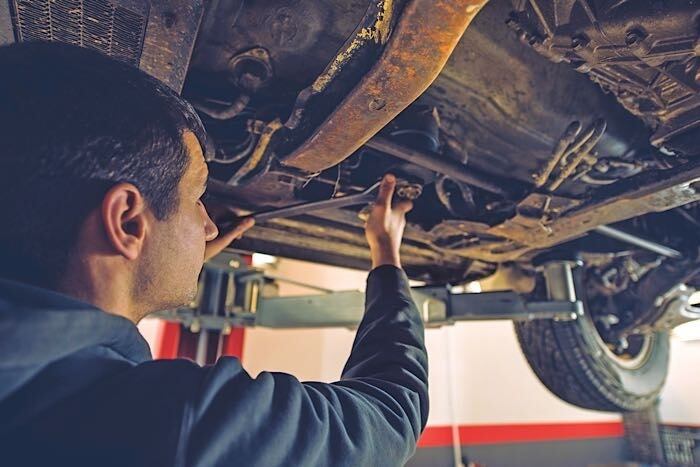Brake lines on a car are located under the chassis and run from the master cylinder to the wheels. The brake lines on a car are a crucial component of the braking system.
They are responsible for transferring brake fluid from the master cylinder to the wheels, allowing the brakes to operate effectively. Located underneath the car’s chassis, these lines are typically made of steel and are designed to withstand high pressure.
Properly functioning brake lines are essential for safe driving, as any leaks, corrosion, or damage can compromise the braking system and lead to a loss of braking power.
Regular inspection and maintenance of brake lines are necessary to ensure optimal performance and safety on the road.

Credit: www.brakeandfrontend.com
Where Does The Brake Booster Vacuum Line Go
The brake booster vacuum line connects to the intake manifold or directly to the engine’s vacuum source. This line is crucial for power braking, as it provides the vacuum pressure needed to assist with braking.
It is essential to ensure that the line is properly connected and free from leaks to maintain the brake system’s effectiveness.
Where Does The Brake Booster Vacuum Line Go?
When it comes to brake systems in cars, the brake booster vacuum line plays an essential role. This line is responsible for creating the vacuum needed to assist in the braking process. The brake booster vacuum line connects the intake manifold of the engine to the brake booster itself.
Let’s dive deeper into where exactly the brake booster vacuum line goes:
Connection To The Intake Manifold:
- The brake booster vacuum line attaches to the intake manifold, which is a crucial part of the engine.
- The intake manifold distributes the air-fuel mixture to the cylinders for combustion.
- By connecting the brake booster vacuum line to the intake manifold, it allows for a vacuum source to be utilized for assisting the braking system.
Importance Of Vacuum Source:
- The vacuum source from the intake manifold is necessary for the brake booster to function effectively.
- This vacuum assists in creating significant braking force, making it easier for the driver to apply pressure on the brake pedal.
- Without a proper vacuum source, the braking system may feel weak, resulting in longer stopping distances and potential safety hazards.
Routing Of The Brake Booster Vacuum Line:
- The brake booster vacuum line is often made of rubber or plastic and is routed through the engine bay.
- It is typically located on the passenger side of the engine compartment.
- The line runs from the intake manifold towards the brake booster, which is usually located near the master cylinder in modern vehicles.
Inspecting The Brake Booster Vacuum Line:
- It is essential to periodically inspect the brake booster vacuum line for any signs of damage or leaks.
- Cracks, splits, or loose connections can significantly impact the performance of the brake system.
- If any issues are detected, it is advisable to replace the line promptly to ensure proper brake operation.
Maintenance And Care:
- To maintain optimal brake system performance, it is recommended to check the brake booster vacuum line during routine inspections.
- Keep the line clean and free from debris or contaminants that can affect the vacuum flow.
- Regular maintenance, including visual inspection and cleaning, will ensure the brake booster vacuum line operates efficiently for a safe driving experience.
Remember, maintaining and understanding the brake system, including the brake booster vacuum line, is crucial for safe and reliable stopping power.
By ensuring the vacuum line is intact and properly connected, you can confidently rely on your brakes when you need them most.

Credit: www.safetybrakeandclutch.co.za
Frequently Asked Questions Of Where Are Brake Lines On A Car
Where Are Brake Lines Located On Car?
Brake lines in cars are typically located underneath the vehicle, running along the frame and connecting the brake system components.
They transport brake fluid from the master cylinder to the brake calipers or wheel cylinders, enabling the application of hydraulic pressure for effective braking.
How Many Brake Lines Are On A Car?
A typical car has multiple brake lines, usually four, connecting the master cylinder to each individual brake.
Where Can I Check My Brake Lines?
You can check your brake lines by inspecting for any signs of leaks or damage. Look under your car for any puddles or wet spots, and examine the brake lines for rust, wear, or corrosion.
It’s crucial to ensure that your brake lines are in good condition for optimal safety.
What Do Brake Lines Look Like?
Brake lines are usually made of metal tubes that connect the brake master cylinder to the brake calipers or wheel cylinders. They can be found underneath the vehicle and run alongside the chassis.
These lines are responsible for transferring brake fluid to the brakes, allowing them to function properly.
Conclusion
The location of brake lines on your car is crucial for maintenance and repairs. By knowing where they are located, you can ensure the safety and efficiency of your braking system.
Regular inspection and timely repairs can prevent potential hazards and maintain the overall performance of your vehicle.
Stay informed and take care of your brake lines for a safer driving experience.
